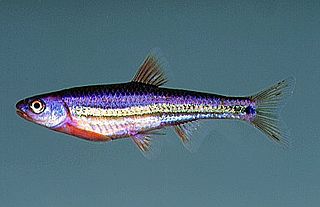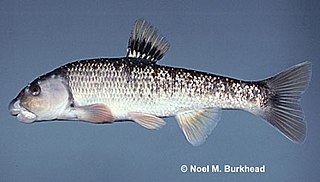Related Research Articles

The mummichog is a small killifish found along the Atlantic coast of the United States and Canada. Also known as Atlantic killifish, mummies, gudgeons, and mud minnows, these fish inhabit brackish and coastal waters including estuaries and salt marshes. The species is noted for its hardiness and ability to tolerate highly variable salinity, temperature fluctuations from 6 to 35 °C, very low oxygen levels, and heavily polluted ecosystems. As a result, the mummichog is a popular research subject in embryological, physiological, and toxicological studies. It is also the first fish ever sent to space, aboard Skylab in 1973.

The mud sunfish is a freshwater ray-finned fish, a sunfish from the family Centrarchidae, which widely distributed in the fresh waters along the Atlantic coast of North America, ranging from New York to Alabama. It is the only species in the genus Acantharchus.

Fundulus is a genus of ray-finned fishes in the superfamily Funduloidea, family Fundulidae. It belongs to the order of toothcarps (Cyprinodontiformes), and therein the large suborder Cyprinodontoidei. Most of its closest living relatives are egg-laying, with the notable exception of the splitfin livebearers (Goodeidae).

Notropis is a genus of freshwater fish in the family Cyprinidae. They are known commonly as eastern shiners. They are native to North America, and are the continent's second largest genus.

The trispot darter is a species of freshwater ray-finned fish, a darter from the subfamily Etheostomatinae, part of the family Percidae, which also contains the perches, ruffes and pikeperches. It is endemic to northern Georgia and southern Tennessee in the United States, where it occurs in the Conasauga River and its tributaries and historically in the Alabama River system. It requires two interconnecting habitats; outside the breeding season it occupies the peripheral zones of the main river, with slow-moving water and silt gravel substrates with vegetation cover; during the breeding season it moves to warmer water with a clay-bottomed substrate with much vegetation. The population of this fish is declining due to loss of suitable habitat because of stream impoundment and land development. The International Union for Conservation of Nature has assessed its conservation status as being "vulnerable".

The sand shiner is a widespread North American species of freshwater fish in the family Cyprinidae. Sand shiners live in open clear water streams with sandy bottoms where they feed in schools on aquatic and terrestrial insects, bottom ooze and diatoms.

The rainbow shiner is a North American species of ray-finned fish in the genus Notropis.
The Stippled studfish is a small freshwater fish which is endemic to the Tallapoosa River system in Georgia and Alabama, USA; and Sofkahatchee Creek in Alabama. It belongs to the genus Fundulus in the killifish and topminnow family, Fundulidae.
The central stoneroller is a fish in the family Cyprinidae endemic to North America.

The largescale stoneroller is a fish in the family Cyprinidae native to the eastern United States.
The southern studfish is a ray-finned fish of the family Fundulidae, the tooth carps, that is native to the southeastern United States.

The Coosa darter is a species of freshwater ray-finned fish, a darter from the subfamily Etheostomatinae, part of the family Percidae, which also contains the perches, ruffes and pikeperches. It is endemic to the eastern United States.
The goldstripe darter is a species of freshwater ray-finned fish, a darter from the subfamily Etheostomatinae, part of the family Percidae, which also contains the perches, ruffes and pikeperches. It is endemic to the southeastern United States where it is found in Gulf Slope streams from the Colorado River drainage in Texas to the Flint River in Georgia, the Atlantic Slope in Ocmulgee River system, Georgia, and the Mississippi embayment north as far as southeastern Missouri and western Kentucky. It is typically found in small springs, streams, and creeks with aquatic and marginal vegetation and detritus. The female spawns on multiple occasions between about mid-March and June, sticking the adhesive eggs to plants, gravel and the sides of rocks. The goldstripe darter is a common species with a wide range and numerous sub-populations, and the International Union for Conservation of Nature has assessed its conservation status as being of "least concern".

Campostoma, the stonerollers, is a genus of cyprinid fish found in North America. There are currently six species recognized for this genus.

The flame chub is a species of freshwater fish in the family Cyprinidae found only in the United States. Its range broadly follows the Tennessee River from above Knoxville, Tennessee, to the mouth of the Duck River. Historically the species was found in Kentucky, Tennessee, Alabama and Georgia. The preferred habitat of flame chub is in small flowing streams often associated with springs.
The bluefin stoneroller is a fish in the family Cyprinidae endemic to the southeastern United States.

The spotfin killifish is a member of the genus Fundulus. This hardy fish is notable for spending its entire life in sporadically flooded salt marsh habitat, sheltering in shallow pools, puddles, and small tidal rivulets. It closely resembles the mummichog in shape and coloration, but the two species can be distinguished by dorsal fin ray count: 8–9 in the spotfin versus 11–12 in the mummichog. Additionally, the dorsal fin of F. luciae originates farther back, and slightly behind the anal fin origin; in the mummichog, the dorsal fin begins anteriorly to the anal fin origin. The spotfin killifish is named for the pronounced ocellus found on the posterior dorsal fin of adult males. It is a small fish, seldom attaining 50 mm in total length. Its distribution extends along the U.S. east coast from Massachusetts to Georgia.

Nothonotus is a genus or subgenus of freshwater ray-finned fish, a darter from the subfamily Etheostomatinae, part of the family Percidae, which also contains the perches, ruffes and pikeperches. It is endemic to the southeastern United States. First proposed as a sub-genus of Etheostoma in 1988, there is still debate regarding the appropriate taxonomic rank of Nothonotus in the literature. Darter species comprise more than 180 of the Percidae taxa.
Limia melanonotata, the blackbanded limia, is a toothcarp in the family Poeciliidae. It is endemic to the island of Hispaniola.
Ernest Albert Lachner was an American ichthyologist with an international reputation for his research on Indo-Pacific gobies and cardinalfishes.
References
- 1 2 King, Joe (February 18, 2008). "The Bob Cashner Biography (Abridged)". UNO Research News. University of New Orleans, Office of Research and Sponsored Programs. Retrieved 14 February 2010.
- ↑ Cashner, R.C., J.S. Rogers and J.M. Grady 1988 Fundulus bifax, a new species of the subgenus Xenisma from the Tallapoosa and Coosa river systems of Alabama and Georgia. Copeia (3):674-683.
- ↑ Froese, Rainer; Pauly, Daniel (eds.) (2010). "Fundulus bifax" in FishBase . January 2010 version.
- ↑ Burr, Brooks M.; Cashner, Robert C. (1983). "Campostoma pauciradii, a new Cyprinid fish from southeastern United States, with a review of related forms". 1983 (1). Copeia: 101–116.
{{cite journal}}: Cite journal requires|journal=(help)